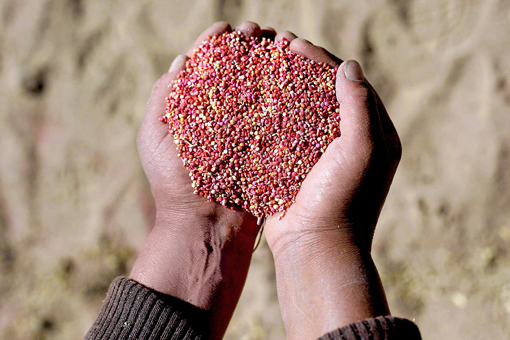Quinoa, which the Incas once considered the “mother grain,” has earned a distinctive honor. In accordance with a December 2011 resolution by the United Nations General Assembly, 2013 will be known as the International Year of Quinoa (IYQ).
But this is not just a salute to an ancient crop. Once marginalized by Spanish conquistadores as a food of the rural poor, quinoa—grown mainly in the Andean altiplanos (highlands) of Bolivia, Ecuador and Peru—is taking the rest of the world by storm.
The European Union, Japan and North America account for a considerable increase in quinoa’s global consumption, thanks in part to consumers drawn to its nutritional benefits, the low environmental impact of its farming, and its organic and gluten-free character. “With the increasing move to eat healthier, and the upward trends in celiac and gluten-free diets, people are looking for more options,” says Christopher Algea, founder of Keen One Foods, a Colorado (U.S.)-based food company.
Quinoa has been harvested for over 7,000 years through techniques perfected by Indigenous peoples. It can also be grown in diverse agro-ecological regions, at a broad range of temperatures. Bolivia, one of the major producers, has been a driving force behind IYQ. Two years ago, it proposed a special year for the grain, and President Evo Morales, an Indigenous Aymara, now serves as the Food and Agriculture Organization’s special ambassador to IYQ. Bolivia produces 46 percent of the world’s quinoa, and has benefited handsomely from the crop’s demand boom—exporting 14,500 metric tons, $25 million worth, in 2009.
But quinoa’s popularity isn’t the only thing that has escalated: its wholesale price increased sevenfold between 2000 and 2011. Many farmers prefer to sell it now instead of keeping it for consumption. For many poor families the onetime staple of the Bolivian diet is now too expensive. Partly because of the price increase and partly because they are eating more rice and noodles, Bolivia’s consumption of quinoa fell 34 percent in the past five years. Today, only one-tenth of the quinoa grown in Bolivia stays in the country, according to Nemecia Achacollo, rural development minister.
As IYQ starts, the year-long commemoration represents a mixed blessing. As the world learns about and adopts a fabled Bolivian staple, the country that brought it to fame is finding less of it on its own dinner tables.





